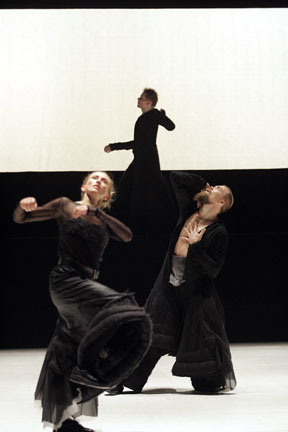Song and Dance
"On
the Town"
English
National Opera
London
Coliseum
From
March 5, 2005
“Borrowed
Light”
Tero
Saarinen Company
&
The Boston Camerata
Queen
Elizabeth Hall
London
April
6, 2005
by
John Percival
copyright
©2005 by John Percival
 Two
song and dance shows have come our way—in very different proportions.
English National Opera decided to give “On the Town” a rare
London showing, and were slated by some critics both for choosing a non-opera
and for (sensibly, I would have thought) bringing in some non-operatic
actor-singers. Luckily for ENO, the public did not concur: bookings have
been so good that extra performances had to be scheduled. I had never
seen the work on stage, only the brilliant but much adapted film, and
am glad to have rectified the omission, especially given the strong show-biz
playing of Aaron Lazar, Adam Garcia and Tim Howar as the three sailors
and Helen Anker, Caroline O’Connor and Lucy Schaufer as their lady-loves.
However, the programme credit “based on an idea by Jerome Robbins”
is a reminder of how important dance is in the show—the idea in
question, you may remember, went by the name of “Fancy Free”
and largely made the name of Leonard Bernstein as well as that of the
choreographer. Jude Kelly, one of our leading theatre directors, assured
the excellent production, but I can’t share her admiration for Stephen
Mear as choreographer; his dances swung along but seemed to me too much
a cheap imitation of the Robbins style. That apart, I much enjoyed the
show.
Two
song and dance shows have come our way—in very different proportions.
English National Opera decided to give “On the Town” a rare
London showing, and were slated by some critics both for choosing a non-opera
and for (sensibly, I would have thought) bringing in some non-operatic
actor-singers. Luckily for ENO, the public did not concur: bookings have
been so good that extra performances had to be scheduled. I had never
seen the work on stage, only the brilliant but much adapted film, and
am glad to have rectified the omission, especially given the strong show-biz
playing of Aaron Lazar, Adam Garcia and Tim Howar as the three sailors
and Helen Anker, Caroline O’Connor and Lucy Schaufer as their lady-loves.
However, the programme credit “based on an idea by Jerome Robbins”
is a reminder of how important dance is in the show—the idea in
question, you may remember, went by the name of “Fancy Free”
and largely made the name of Leonard Bernstein as well as that of the
choreographer. Jude Kelly, one of our leading theatre directors, assured
the excellent production, but I can’t share her admiration for Stephen
Mear as choreographer; his dances swung along but seemed to me too much
a cheap imitation of the Robbins style. That apart, I much enjoyed the
show.
 Also
highly enjoyable was “Borrowed Light”, which came for a one-night
stand at the Queen Elizabeth Hall. The production is a collaboration between
the eight dancers of the Tero Saarinen Company and the eight singers of
the Boston Camerata, directed respectively by the Finnish choreographer
Saarinen and the American musician Joel Cohen. Their joint inspiration
is the songs of the Shaker sect. The title “Borrowed Light”
alludes to a Shaker habit of providing windows in internal walls so that
a room can gain illumination from another, but it makes better sense as
referring to the way Saarinen and Cohen have drawn inspiration from the
music. The sixteen performers share the stage, all dressed in black and
seen against a structure of platforms that form wide shallow steps; the
cast often stand or sit on the lowest of these, and one or two will often
climb and descend to pass behind the on-stage players. The dances imply
a kind of invented folk art, and the singers are trusted with movement
too. There is a kind of ritual going on, drawing on various forms of solo,
duet or ensemble, but looking original and inevitable. Erika Turunen’s
costumes doubtless draw on but certainly don’t imitate Shaker garments
(the women dancers’ dresses, although chaste enough, are certainly
sexier in detail than this devoted community would have worn); Mikki Kunttu’s
lighting ideally complements the action. Saarinen cites community and
devotion as his subject, and with his collaborators has achieved a result
that constantly surprises and holds the attention.
Also
highly enjoyable was “Borrowed Light”, which came for a one-night
stand at the Queen Elizabeth Hall. The production is a collaboration between
the eight dancers of the Tero Saarinen Company and the eight singers of
the Boston Camerata, directed respectively by the Finnish choreographer
Saarinen and the American musician Joel Cohen. Their joint inspiration
is the songs of the Shaker sect. The title “Borrowed Light”
alludes to a Shaker habit of providing windows in internal walls so that
a room can gain illumination from another, but it makes better sense as
referring to the way Saarinen and Cohen have drawn inspiration from the
music. The sixteen performers share the stage, all dressed in black and
seen against a structure of platforms that form wide shallow steps; the
cast often stand or sit on the lowest of these, and one or two will often
climb and descend to pass behind the on-stage players. The dances imply
a kind of invented folk art, and the singers are trusted with movement
too. There is a kind of ritual going on, drawing on various forms of solo,
duet or ensemble, but looking original and inevitable. Erika Turunen’s
costumes doubtless draw on but certainly don’t imitate Shaker garments
(the women dancers’ dresses, although chaste enough, are certainly
sexier in detail than this devoted community would have worn); Mikki Kunttu’s
lighting ideally complements the action. Saarinen cites community and
devotion as his subject, and with his collaborators has achieved a result
that constantly surprises and holds the attention.
Volume 3,
No. 14
April 11, 2005
copyright
©2005
John Percival
www.danceviewtimes.com
|
|
|